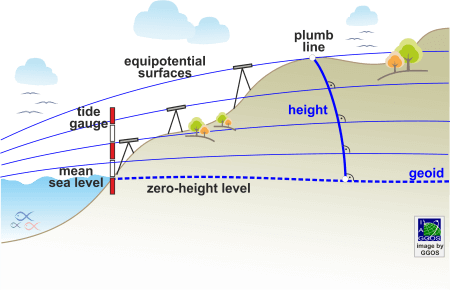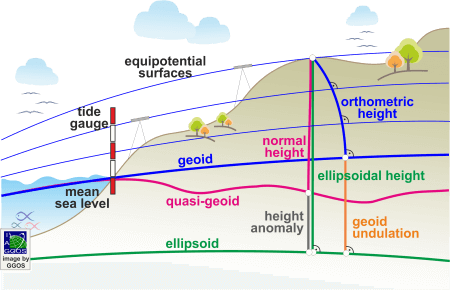Height Systems
Why are height systems so important?
A height system is a one-dimensional coordinate system used to express the metric distance (height) of a point above a reference surface (i.e., the zero-height level) along a well-defined path. Particularly, the physical heights are determined using geodetic levelling techniques that measure the distance between two equipotential or level surfaces of the Earth’s gravity field and provide the height along the curved plumb line. As the height determination depends on the level surfaces and the plumb line of Earth’s gravity field, these coordinate systems are called physical height systems. These coordinate systems are called physical height systems as the height determination depends on the level surfaces and the plumb line of Earth’s gravity field. The physical heights are referred to the geoid, a particular equipotential surface of the Earth’s gravity field that is close to the mean sea level. From the practical point of view, the mean sea level has been assumed as the zero-height level and inferred from averaged tide gauge records over certain time intervals. Since the mean sea level differs from the geoid (up to 2 m at global scale) and from point to point, the heights determined along the so-called vertical or levelling networks referred to a given tide gauge define a local height system. Presently, more than 100 local physical height systems are in use.
Detailed Description
A height system is a one-dimensional coordinate system used to express the metric distance (height) of a point above a reference surface (i.e., the zero-height level). If the reference surface and the height are linked to equipotential surfaces and the plumb line of the Earth’s gravity field, the height system is called physical height system. If the reference surface and the height do not depend on the Earth’s gravity field, the height system is called geometric height system. In the latter, the reference surface is a reference ellipsoid and the vertical coordinate is the ellipsoidal height, which is usually derived from satellite positioning techniques (i.e., GNSS: Global and Navigation Satellite Systems). The reference surface of most of the existing physical height systems is linked to the mean sea level determined at a tide gauge. As the mean sea level varies geographically and with time, mean sea level values used for the definition of the zero-height level in different countries may present discrepancies up to some decimetres. The traditional way to obtain physical heights is geodetic levelling in combination with gravity reductions along the so-called vertical or levelling networks. The gravity reductions are necessary to take into account the non-constant separation between equipotential surfaces due to variations of the Earth’s gravity field. Depending on the gravity correction applied to levelling, different types of physical heights are distinguished: orthometric heights, normal heights, or dynamic heights. Thus, the height of a point can be determined in many slightly different ways, each of which gives a different height coordinate for the same point.
Orthometric and normal heights are widely used in the definition and realisation of physical height systems, while dynamic heights are mainly employed to define the height coordinate in water bodies (e.g., large lakes). Physical height systems based on orthometric heights use the geoid as reference surface. The geoid is the equipotential surface that best fits the mean sea level. Physical height systems based on normal heights use the quasi-geoid as reference surface. The quasi-geoid is close to the geoid but not an equipotential surface as the geoid is. The quasi-geoid deviates from the geoid in the same way as the normal heights deviate from the orthometric heights. They present differences on the millimetre to centimetre order at low elevations and may reach 1 m deviation in high mountains. On the oceans, geoid and quasi-geoid as well as orthometric and normal heights practically coincide. The transformation between geometric and physical height systems is given by ![]() , where h is the ellipsoidal height,
, where h is the ellipsoidal height, ![]() and
and ![]() are the orthometric and normal heights, respectively,
are the orthometric and normal heights, respectively, ![]() is the geoid undulation, and
is the geoid undulation, and ![]() is the height anomaly. The geoid (
is the height anomaly. The geoid (![]() ) and the quasi-geoid (
) and the quasi-geoid (![]() ) are to be determined by precise gravity field modelling approaches and may be combined with GNSS positioning to obtain physical heights, without the necessity of performing levelling surveys.
) are to be determined by precise gravity field modelling approaches and may be combined with GNSS positioning to obtain physical heights, without the necessity of performing levelling surveys.
As most of the existing height systems refer to local mean sea level values (and consequently to local geoids) and are realised by national or regional levelling networks covering specific regions, they are utilisable over limited geographical areas only. Thus, they are local height systems. At present, there are about 100 local height systems in use. Current efforts concentrate on the realisation of a global unified height system based on a common reference level for all the regions over the world and a unique, coherent vertical coordinate (see GGOS Focus Area – Unified Height System). This system is called the International Height Reference System (IHRS) and its realisation is given by the International Height Reference Frame (IHRF).




